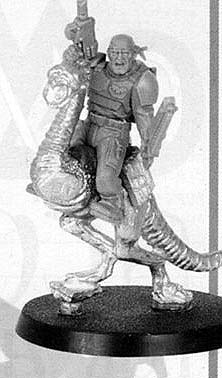| by Andy Chambers, Pete Kaines, Andy Mure, Phil Kelly, Graham McNeill and Mat Ward 
This month's Chapter Approved takes something of a break from the normal fare of interesting army variants and indispensable FAQs to bring you rules and background for using some of the more combatant fauna to be found in the Wamammer 40,000 universe. The reason for doing this is simple; we believe that we're all guilty of focusing on what's 'official' and usable in tournaments, sometimes at the expense of what's just good clean fun. Such rules as these formed the mainstay of Rogue Trader, the first edition of Warhammer 40,000, and as we all fondly recall many of the more wacky rules from those days we thought it might be fun to revisit some of them in Chapter Approved... 21st century-style.
Andy Chambers' Enslavers and Mat's Catachan Devils rules are something else again - unusual projects for modellers and gamers that fancy a challenge. We had enormous fun writing these rules, and there are a whole load more ideas we discussed that we ended up leaving out, often because of the difficulty of suggesting modelling options (Ambulls for example). However, if there's the demand for it we may revisit the Creature Feature in the future. We'd also like to encourage players to write their own rules for such creatures, and although you obviously don't need our blessing to use them in your own games, we'd be interested to see what you've come up with, and perhaps may include some in a future Chapter Approved. One last word on these rules. It goes without saying that they all require your opponent's consent and are optional. Players should agree whether any of these rules are to be used, and in this sense they are ideal for use in a campaign. Even in one-off games though, we reckon players should be open to experiment in this manner. If your opponent vetoes the use of optional rules on the basis that they may interfere with his finely-honed battle plan, feel free to point and laugh at him for his lack of gaming spirit! CATACHAN DEVILS BY MAT WARD Catachan Devils are native to the Catachan system, and these ferocious and rapacious beasts have truly earned their name.
The Devils are superbly adapted to their jungle environment, their segmented, multi-legged bodies able to move with surprising speed over all manner of lerrain before coiling to spring upon their unsuspecting prey. Once captured, the unfortunate victim is either shredded by razor sharp claws or stung into insensibility by the poisoned barbs around the mouth of the Devil and then consumed. Fully grown Devils vary in size from a few metres to over thirty. Older male Devils occasionally develop stronger grasping claws, one of which is often much larger than the other. These highly individualistic creatures have been dubbed 'fiddlers' in Jungle Fighter slang and are rightly feared for their strength and ferocity. Territorial yet social creatures. Catachan Devils tend to form nesting groups of several large Devils and several dozen juvenile 'Devilspawn'. The entire group will always defend its territory from any intruders, whether they be competing Devil nestings, other predators, colonists, or even Imperial Guard Tank companies. For many years Catachan has been prized by the Imperium for the excellent training that its denizens provide to the units of the Imperial Guard formed there and has often sought to further utilise the sheer killing power of the Devils. Though the Imperium has been unsuccessful in training or taming them, Devils have often been introduced to Imperial worlds in order to dissuade invaders. This proliferation has inevitably led to escapes, and there have been rumoured sightings of Devil nests on hive worlds and colonies all over the Imperium. Catachan Devils know no allegiance save to their own nestings and. to a degree, their own stomachs. This makes them well suited to being used by a third player (or a referee in the case of campaign games) in any of the standard missions. They are deployed using the Hidden Set-up rules anywhere on the board other than established Deployment Zones before any other player places his forces. Note that as Catachan Devils and Devilspawn never capture objectives or table quarters, their only way to win missions such as Cleanse is through sheer attrition. More often, the Catachan Devils player will just want to make life difficult for the other players!
Number/Squad: 1 Devil or 1-5 Devilspawn (if constructing an 'army' count the Devils as HQ or Elites and the Devilspawn as Troops, Fast Attack or Heavy Support). Options: One Devil may be upgraded to a Fiddler for +25 points. Fiddlers are Strength 8.
Monstrous Creature: Catachan Devils are massive, brutal killing machines. They roll 2D6 for Armour Penetration and ignore their opponent's Armour saves in close combat. This special rule does not apply to Devilspawn. Difficult and Impassable Terrain: Both Devils and Devilspawn can negotiate all kinds of impeding terrain with ease. Devils and Devilspawn roll an extra D6 when negotiating difficult terrain. In addition, they treat Impassable Terrain as il it were difficult, so long as they roll high enough to pass through it in one move - if they do not roll high enough they simply stop at the edge. Stealth: Devils and Devilspawns are able to blend into foliage silently and swiftly, all but invisible to the naked eye. They gain +1 to their Cover save while in jungles or forests. Fleet of Foot: Devils and Devilspawns are able to cover a vast distance swiftly in great bounding springs. In the Shooting phase, any Devil or brood of Devilspawn may move an additional D6" (provided they are not engaged in combat). This additional movement ignores difficult terrain. Burrow: Devilspawn often creep up on their prey by tunnelling underground. Devilspawn may Deep Strike if the mission allows. Objectives: Devils and Devilspawn never capture objectives of any kind. They have no interest in things they cannot eat or kill. The origins of these strange creatures, also Known as Psyrens, Krell, dominators or puppeteers in different parts of the galaxy, is a complete mystery to Humanity. They have physical bodies but appear to exist in Warp space for at least part of their life cycle and pose a terrible threat to all living creatures when they breach the material realm.
Descriptions of Enslavers are rare and fragmentary but they all indicate beings with a spherical (or conical) body trailing a mass of tentacles and capable ot floating up to 3 metres above ground level. The tentacles can be used to manipulate objects and climb, and their body colour can be changed at will but is most commonly reported as leathery brown with paler, pinkish tentacles. In human terms it is impossible to say whether Enslavers are intelligent. They appear to act in a rational manner and seem able to make reasoned decisions about their actions. However. if they are able to communicate with other races they make no attempt to do so, and they use no tools or equipment of any kind. All manual work is done by psychically controlled slaves, and it is this power which gives them their name. Enslaver victims become complete puppets to the alien's will, performing even the most self-destructive acts without hesitation. Enslavers travel on the currents of the Immaterium and are drawn to the psychic emanations of living creatures. The strongest emanations come from unprotected psykers and Enslavers can detect these from tens of light years away. Once a psychic host is found Enslavers form a mental bond with it and bring about a sickening transformation. The host is distorted and twisted over a period of days to form a living warp portal, a pulsating arch of ruptured flesh which permits the Enslavers egress into the material plane. Once Enslavers have appeared on a world they seek out and transform more psykers so that more and more Enslavers appear. Once an Enslaver infestation has begun it is very hard to stop.
The easiest way to use Enslavers is as an alternate HO choice to represent an enslaved army. Alternatively in games with multiple players and/or a games master Enslavers make an ideal 'unknown force' to plague all sides by enslaving their units. Unit size: Enslaver 1-3 Deep Strike: Enslavers may always opt to stay in reserve and enter play using the Deep Strike rules even in missions which do not use the Deep Strike rules. Enslavers cannot contribute dice to the Enslavement pool until they are on the tabletop. Enslavers get a dice pool for mind control. Each Enslaver contributes 1 dice. Enslavers may upgrade to contributing up to 5 dice at an extra +15 pts per dice. Dice are used to control enslaved units and to mind control new ones! The dice pool is used as follows: In the Enslaver's turn it allocates dice to utilising its already enslaved units. Any dice left over can be used to try and take over opposing units either in the Enslaver's turn or the opponent's turn. At the start of the next Enslaver's turn the pool is refilled with the exception of dice that have been left with units to show they are in danger of permanent enslavement (see below). Exceptions: Many, many beings and entities in the Warhammer 40,000 galaxy could claim to be an exception to being enslaved. However, Enslavers seem capable of controlling absolutely anything with an unstoppable combination of psychic trickery and sheer mental force, so for these (slightly tenuous) reasons ALL units can potentially be enslaved, even vehicles, Necrons, Tyranids, Daemons etc etc. Units without a Leadership characteristic count as having Ld 10. Enslavers count as psykeis but their Enslavement dice cannot be countered by any known means such as psychic hoods or Runes of Warding. Enslaved units require one dice a turn in order to do anything, two to be brought fully under control. Enslaved units with just one dice have to roll it; 1-3 May only move or shoot, may not assault but will fight if already in close combat. 4-6 May move, shoot and assault normally. Enslaved units without any dice are left confused and starting to come to their senses, they do nothing at all for the turn, they will not even fight back in close combat, although their weapon skill is unaffected. Enslaved units are always Fearless so they automatically pass all Morale checks and cannot be pinned. Enslaving new units is achieved by allocating dice to them and rolling against the target unit's Leadership characteristic. A maximum of three dice can be allocated per enemy unit and one dice is lost per full 24" there is between the closest Enslaver and the target (ie. 24"-47" -1 dice, 48"-71" -2 dice, control is not possible at 72" or greater). The dice can be rolled at any time but must be allocated at the start of the Enslavers turn. The following result apply: Equalling the Ld: The target is confused and does nothing, this has no immediate effect if it's the Enslaver's turn but if it's the opponents turn the unit takes no other actions for the remainder of the turn and will not fight back in close combat. The opponent must remove one model from the unit for each 6 rolled on the dice to represent infighting - individuals being completely controlled and killing another unit member, ones winning free only to be slain by the others, suiciding and so forth. Beating the Ld by one: The Enslaver can cause the unit to move, this will be an additional move of up to 6" in the Enslaver's turn. The unit can be moved into terrain that is dangerous or difficult for it, but not impassable. If the dice were rolled in the opponent's turn treat this as equalling the Ld of the target. Beating the Ld by two: The Enslaver can cause the unit to move as above and shoot in the Enslaver's turn, targeting the nearest unit, friend or foe. If the dice were rolled in the opponent's turn treat this as equalling the Ld of the target. Beating the Ld by three or more: The Enslaver can cause the unit to move up to 6". shoot and assault up to 6". effectively controlling the unit for the Enslaver's turn. It the dice were rolled in the opponent's turn treat this as equalling the Ld of the target. Permanent Enslavement: Each time an enemy unit is affected by the Enslavers leave one of the dice from their pool with it. Once three dice have been accumulated the unit becomes fully enslaved and is part ot the Enslaver's forces from then on. At this point the accumulated dice are returned to the Enslavers' dice pool. Mind control: The Enslaver's effect gets more powerful the closer you get. Within 6" units are at Ld -2. within 12" -1 Ld. Psykers suffer an additional -1 at any range. Psychic Lash: In close combat Enslavers can add unused Mind Control dice as additional attacks to represent the effects of its psychic lash. An Enslaver may not use more dice for attacks than they contribute to the dice pool. Close combat attacks from Enslavers ignore Armour saves.
Giant reptiles are a relatively common life-form throughout the galaxy, especially on death worlds and feral worlds where they are often the main predator type. A giant reptile typically ranges from the size of a bike to that of a Land Raider, is possessed of considerable strength and ferocity, and has vicious natural weapons ranging from sharp bony protrusions and claws to jaws capable of ripping open the hull of a Rhino APC. It is quite common for the worlds from which the Space Marines recruit to have such lethal predators stalking the inhospitable terrain, and for young aspirants to prove themselves by slaying one of these immense beasts and taking a trophy to prove his ascent to manhood. Needless to say, few make it back alive. Carnosaurs prowl the blasted wastes of the Triath sector, and the infamous Arcanadonts, top of the evolutionary ladder in the honeycombed mining world of Mordant, are sold across the Segmentum as vicious pets and status symbols at a great cost in both life and raw meat. Giant reptiles are also used by other races, the feral Eldar of the Exodite worlds often harnessing the gigantic megasaurs native to their world, forming a limited symbiosis and even riding them to war. You can use giant reptiles in your games in two different ways, you must agree upon which way you use them with your opponent. They can be fielded either as denizens of the world upon which you are fighting, or as riding beasts for your own troops. Untamed, they are voracious predators without fear, and will attack anything that they come close to. As riding beasts, they can be controlled, and add a tremendous amount of power to any close combat specialists' attack. If you decide to use them as native beasts, agree with your opponent to set up as many giant reptiles as you want in areas of difficult terrain at the beginning of the game. They move towards the nearest non-giant reptile unit on the D6 roll of a 2-6 at the beginning of each turn, otherwise they will move D6" in a randomly determined direction. If they are within range at the beginning of any Assault phase, they will engage the nearest unit and fight as if they were an assaulting enemy unit. A unit that kills a giant reptile gains Victory Points for the kill as if it were a member of the opposing force. If you decide to use a giant lizard as a riding beast, pay the points listed below from your army list allowance. It counts as a Heavy Support choice and as part of your army in all respects: you may control it as you wish. Mount a suitable model on the back of the beast or to the rear of it to represent its rider/handler; the profile of the rider/handler is included in the giant reptiles profile and to all intents and purposes it is treated as a single model.
Monstrous Creature: A giant reptile is a huge and fearsomely strong beast. It is most definitely a monstrous creature and therefore rolls 2D6 for Armour Penetration against vehicles and ignores opponent's Armour saves in close combat. Crushing Bite: If a giant reptile hits with all of its attacks, it may nominate one model in base contact with it. That model takes a further 03 wounds with no Armour saves allowed at the end of the round, in addition to the normal consequences of such a successful attack. Amphibious carnivores that prefer to live in and around large tropical and sub-tropical rivers, Crotalid are large, reptilian beasts with long, scaled bodies supported on short, powerful legs capable of short bursts of speed when attacking. A Crotalid's head is draconic; its powerful jaws filled with serrated, triangular teeth that never stop growing throughout its life and are fully capable of biting through the thickest armours. Imperial xenologisis are unsure how long Crotalid live, as their unique migratory habits mean it is almost impossible to track packs of these beasts (see below). It is suspected that the Crotalid originate from somewhere around the Lost Hope death world, though this has never been verified. Crotalid are fearsome predators, lurking in deep waters or concealed along the banks of rivers to attack their prey, and a fully-grown specimen is fully capable of bringing down prey many times its size with its vicious jaws and razor sharp claws. They are almost impervious to injury, their rudimentary nervous systems able to withstand the most heinous damage before the animal dies. Crotalid quickly grow to dominate their habitats, ascending to the top of the food chain within a few decades. Once the Crotalid population reaches saturation point the Crotalid begin their unique form of migration. Once the Crotalid population have dominated their current habitat to the extent that they have destroyed the creatures they feed upon, it becomes necessary for them to move on or face extinction. While most creatures migrate simply by walking, flying or swimming to new habitats, the Crotalid employ an altogether more unusual method to reach new feeding grounds. The Crotalid travel through the medium of Warp space, vanishing from the depopulated habitat and reappearing on a new world, often many light years away. There appears to be no conscious manipulation of this power as Crotalid are not creatures of intelligence, displaying pack animal mentality and often appear on worlds not particularly suited to their needs. When they arrive on their new homeworld, Crotalid are extremely aggressive, attacking anything within sight to establish their territory and dominance of the local area, though it they encounter a threat they cannot defeat, they will often simply vanish, seeking a less hazardous environment. How the Crotalid are able to achieve travel through Warp space is unknown, as repeated dissections have not revealed any method by which this ability might be manifested. Migrating packs vary in number from between four or five beasts to anything up to a hundred, though given the difficulty in tracking these creatures through the Immaterium, this is hard to say with any degree of certainty. If the idea of aggressive, Warp-travelling reptiles appeals to you, then introducing a pack of angry and hungry Crotalids could be just the thing. Obviously, you and your opponent will have to agree to use these toothy reptiles beforehand, as it would be a little unfair to spring them on someone who wasn't expecting these new arrivals to the battlefield.
Unexpected Migration: To represent the sudden arrival of a pack of Crotalids, these creatures always start the game in Reserve, even in missions that don't normally allow it. Roll at the beginning of the game turn and when they become available, roll a Scatter dice and 3D6 in the centre of the table and place the large blast template that number of inches from where the Scatter dice lands in the direction of the arrow. If this carries them off the table, or into impassable terrain then simply re-roll the dice. A pack of 2D6 Crotalids (or as many as you have available) appears at this point and immediately follows the rules below. Territorial: Crotalid are extremely territorial and once they've arrived, they're going to fight to drive any other inhabitants out of their new habitat! If not engaged in an assault, move the Crotalid pack 6" towards the nearest model (from either side) at the beginning of each player's Movement phase, before any other rolls or moves have been made. If this carries them into contact with a model from either side, then the Crotalid count as having charged. Animal Nitrate: Though Crotalid are not normally particularly fast, they are capable of short, rapid bursts of speed when attacking. If, at the beginning of each player's Assault phase, the Crotalid pack are not already engaged in close combat, they must make an Assault move of 12" towards the nearest model (from either side) if this would bring them into contact with it. If no model is in range, then the Crotalid do not move. Animalistic: Crotalid may retreat from their new habitat if they encounter a species more powerful than they are and to represent this, if a pack of Crotalid fails a Morale test from any source, they will immediately trigger their Warp-travelling ability and vanish from the battlefield. Victory Points are scored as normal by the player that manages to drive the Crotalid from the battlefield, either by killing them or causing them to disappear into the Warp. Ah, the delicate bouquet of rotting flesh, the signature shambling walk, the dulcet cry of 'braiiins'. Who can deny the appeal of the good old-fashioned living dead? Almost every horror or sci-fi fan has a soft spot for our squishy cannibalistic friends, the zombies. Including us. Those of you involved in last summer's Eye of Terror Campaign will most likely remember the Plague Zombies, victims of a virulent and deadly infection spread by the minions of Nurgle. Not only did they shuffle off this mortal coil as a result of the Chaos invasion, but they shuffled right back again as undead, hell-bent on adding their former comrades in arms to their number. Luckily for zombiephiles out there, not only is there an excellent plastic kit of zombies that combines perfectly with many of the other plastic kits in the 40K range (notably the Cadians and Catachans), there are many and varied reasons for including the living dead in your games. Here's a few of them for you to incorporate into the storylines of your games.
OK, you get the picture. Here are some hard and fast rules for Zombies in your games, feel free to modify them to fit the game you're thinking of playing. 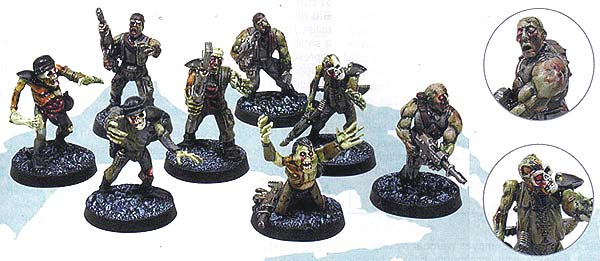
Number/Squad: 1-50 Weapons: Broken dirt-encrusted nails, crude clubs, yellowed teeth, limbs, bones, scythes, chainsaws... Regardless of what the Zombie attacks with he is always treated as having a single close combat weapon. Options: Any squad can be upgraded to being Relentless at +3pts per model, and if so will benefit from the Feel No Pain rule, below. Shamblers: Zombies always move as if in difficult terrain. Fearless: Zombies are Fearless and hence will automatically pass any Morale or Leadership test and cannot be Pinned. Feel No Pain: If a Relentless Zombie loses a wound, roll a D6. On a 4+ the wound is ignored - the Zombie has lost its legs or some other non-vital part and keeps on crawling. This ability cannot be used against weapons whose Strength is at least twice the Zombie's Toughness or against close combat weapons that allow no Armour save. Now grab a bunch of Zombie models, get a scenario together, and go send some undead back to their graves... On many worlds inhabited by humans, as well as those under the sway of deviant xenos, native fauna are utilised as hunting beasts or pack animals. These rules allow you to field hunting beasts of your own devising in your army. Examples of such creatures include the Mordant Pit Rat. the Gladehounds of Canak, the Icebacks of Cthelle and the Bloodstalkers of Flotis III. There are no restrictions on which army can take these beasts, so long as they are represented by thematically appropriate models. For example, it may seem odd for a Necron Lord to be accompanied by such a beast, but if it were modelled similar to a Scarab would be perfectly appropriate. Similarly, some of the old Tyranid range could be used to create hunting beasts to accompany a Tyranid Hive Tyrant.
Bio-diversity: There are so many different hunting beasts utilised by the different races of the galaxy that to include even a small proportion of them here would be impossible. In order to represent some of their different characteristics, you may chose to upgrade all the beasts taken by a character by choosing one or more of the following upgrades. You must upgrade all of a character's beasts to represent the same beast - things would get ugly if the pack was made up of different animals. Agile (+2 points per beast): Each beast has an Initiative of 4. Vicious (+2 points per beast): Each beast a Weapon Skill of 4. Snappy (+2 points per beast): Each beast has a Strength of 4. Alert (+1 point per beast): The beast is able to detect hidden enemy troops. If enemy infiltrators set up within a distance equal to 1D6 for each hunting beast accompanying the character, the character is allowed to take a 'free' shot at them (or sound the alarm in a Raid scenario). If the character is part of a unit, the whole unit may shoot. These shots are taken before the game begins and may cause infiltrators to fall back. - THE LESSER CATACHAN BARKING TOAD (CATACHANUS MORIBUNDUS MINOR) BY ANDY HOARE The Great Barking Toads of the death world of Catachan are believed to be the most devastatingly poisonous creatures in the galaxy. These reclusive amphibians have a unique self-defence mechanism - upon contact with a predator, the Barking Toad simply explodes, releasing a cloud of the most deadly poison known to Mankind half a kilometre in every direction. So virulent is this poison that no known armour will hold it at bay. Every biological organism within the poison's zone of eftect, including the Barking Toad itself is reduced to a formless, slimy mass, and no vegetation will ever grow there again. Tempting as it is to include rules for a Great Catachan Barking Toad, any game involving such a creature would be over the first time a shot was fired, or a chainsword powered up. So. instead of the Great Barking Toad, here's the rules for its smaller cousin, the Lesser Catachan Barking Toad, an altogether less destructive, though equally poisonous creature that can be introduced into your games of Warhammer 40,000 should you be in the mood for some toad-related shenanigans... Society for the Appreciation ot the Lesser Barking Toad: By mutual consent, any number of Barking Toads can be introduced to a game, but they should only be used if both players are looking for an entertaining battle. One toad will make for an interesting twist that shouldn't interfere with gameplay too much, and the more you use the more they will dominate the game, in terms of both army's tactics and the amount of time spent moving them around. They are particularly appropriate for games using the Jungle Fighting rules found in Codex: Catachans. Habitats of the Lesser Barking Toad: Catachan Barking Toads tend to live in or near dark, dank, shady places, and don't really appreciate being disturbed. At the beginning of the game, before rolling for sides, who goes first or who's making the tea, but after terrain has been placed, choose the piece of terrain closest to the centre of the table, and place the Barking Toad in the centre of it. Then roll a Scatter dice and move the Toad 2D6" in the direction indicated (if a 'Hit' is rolled use the small arrow}. Once this is done, carry on with the game setup as normal.
Habits of the Lesser Barking Toad: Catachan Barking Toads can be unpredictable little blighters, one moment hopping all over the place, the next hiding under a nice dark rock. At the beginning of each player's Movement phase, before any other rolls or moves have been made, roll a Scatter dice and move the Toad D6" in the direction indicated. This move is unaffected by difficult terrain. If the Scatter dice rolls a 'Hit' then the Toad decides to stay right where it is for the moment. Biology of the Lesser Barking Toad: The Toad will unleash its poison attack if it makes contact with any enemy (ie. not another Toad) other than Imperial Guard with the Jungle Fighters Doctrine, or Kroot warriors, or if any unit or vehicle shoots while within 3" of it. Resolve the detonation once the unit/vehicle's shooting is complete. When it explodes place the large blast marker over the Toad. All models under the template, except close-topped vehicles, Necrons, C'tan, Daemons and Eldar Avatars take a single Strength 10, AP1 hit, even if only partially covered by the template. Invulnerable saves are alowed as normal. Should the Toad be assaulted, it will explode before the enemy has a change to strike. It will also explode should it be successfully hit by any shooing attack, tank shocked or included in the area of another Toad exploding. Should a Kroot or Imperial Guardsman with the Jungle Fighters Doctrine assault it, treat it as WS1, T2, I2. If it is wounded it is removed as a casualty, but if it survives to strike back it will immediately explode. Imperial Guard armies often contain squadrons or even regiments of Rough Riders. The most famous of these are the Atillan regiments, fierce nomads born in the saddle who have served the Imperium since its earliest days. The majesty, speed and ruthlessness of these warriors has led to many other regiments of horsemen being incorporated into Imperial armies, Ultimately though their weakness lies in the vulnerability of their mounts. There is a strong affection amongst Mankind for horses, based on their long association that encourages their weaknesses to be overlooked. In the grim darkness of the 41st millennium, however, the demands of constant war have led some to consider whether there are xeno species that could do the job better.
One of several species that have been experimented with is the hunting lizard of Kashann. Kashann is a young world, mountainous and volcanic with thick, fast-growing jungles and oceans of primordial swamp. The hunting lizards were one of the most successful local predators, functioning in packs they posed a very real threat to the early human colonists until they were successfully domesticated and bred in captivity. Over time the hunting lizards became a much-valued means of patrolling the wild expanses of Kashann and when the world was populous enough to be tithed it was inevitable that the regiments raised there would be cavalry mounted on hunting lizards. This doctrine may be selected by an Imperial Guard Regiment that has access to Rough Rider Squadrons. Treat this as a special kit doctrine. Whole squadrons of Rough Riders may replace their horses with hunting lizards at a cost of 4 points per model. Hunting lizards do not have the sheer pace of a horse and do not therefore get a Fleet of Hoof move. They improve the rider's Armour save by 1 as their thick hides and bulk offer considerable protection. In close combat each rider will have an additional attack at their own Initiative and Weapon Skill but with Strength 4 representing the fearsome bite o! the lizard. This attack is unmodified by weaponry. |
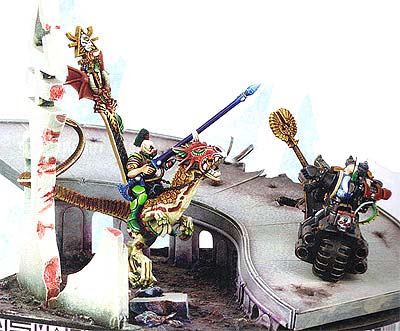 Some
of these rules are essentially random encounters' - creatures that pop
up during a normal game and cause all manner of mayhem. Graham's Crotalids
and Andy Hoare's Barking Toads are both good examples of this. You'll
need to agree with your opponent well before the game that this is the
sort of battle you're after, and play it in that spirit. Phil`s Giant
Reptiles introduce a new unit type into your army, which provides a
cool modelling project as much as an opportunity to field an unusual
unit every once in a while. Pete has taken the opportunity to provide
Imperial Guard players with a new Regimental Doctrine, one of many he
has squirreled away for future use after his work on Codex: Imperial
Guard.
Some
of these rules are essentially random encounters' - creatures that pop
up during a normal game and cause all manner of mayhem. Graham's Crotalids
and Andy Hoare's Barking Toads are both good examples of this. You'll
need to agree with your opponent well before the game that this is the
sort of battle you're after, and play it in that spirit. Phil`s Giant
Reptiles introduce a new unit type into your army, which provides a
cool modelling project as much as an opportunity to field an unusual
unit every once in a while. Pete has taken the opportunity to provide
Imperial Guard players with a new Regimental Doctrine, one of many he
has squirreled away for future use after his work on Codex: Imperial
Guard.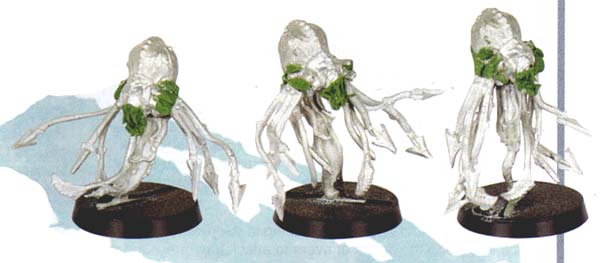
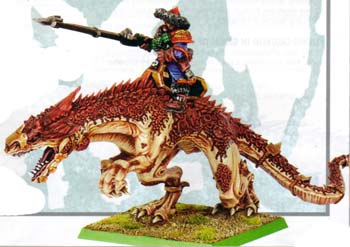
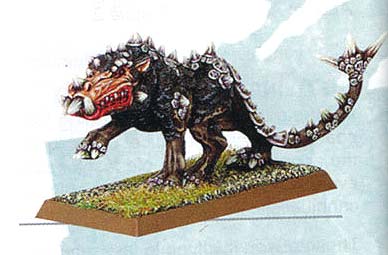 Up
to four Hunting Beasts may be taken as wargear by any character in the
army with access to its armoury. If taken by an Independent Character
they form a unit with that character but do not prevent that character
joining a unit as normal. If selected by a model that is not an Independent
Character they will form part of the unit that the character belongs
to. They are removed if their owner is killed. Hunting beasts move and
assault at the same speed as their master. They do not have to take
Difficult Terrain tests. They may board the same transport as their
master and take a single space each.
Up
to four Hunting Beasts may be taken as wargear by any character in the
army with access to its armoury. If taken by an Independent Character
they form a unit with that character but do not prevent that character
joining a unit as normal. If selected by a model that is not an Independent
Character they will form part of the unit that the character belongs
to. They are removed if their owner is killed. Hunting beasts move and
assault at the same speed as their master. They do not have to take
Difficult Terrain tests. They may board the same transport as their
master and take a single space each.